Planting, growing and caring for kohlrabi cabbage
Kohlrabi is not the most popular variety of cabbage among gardeners. Despite the pleasant, delicate taste, benefits and possibility of using the vegetable in dietary nutrition, many summer residents do not risk growing it, fearing difficulties in care. We offer detailed information about the intricacies of cultivating kohlrabi and how to care for the plant.
Growing kohlrabi through seedlings
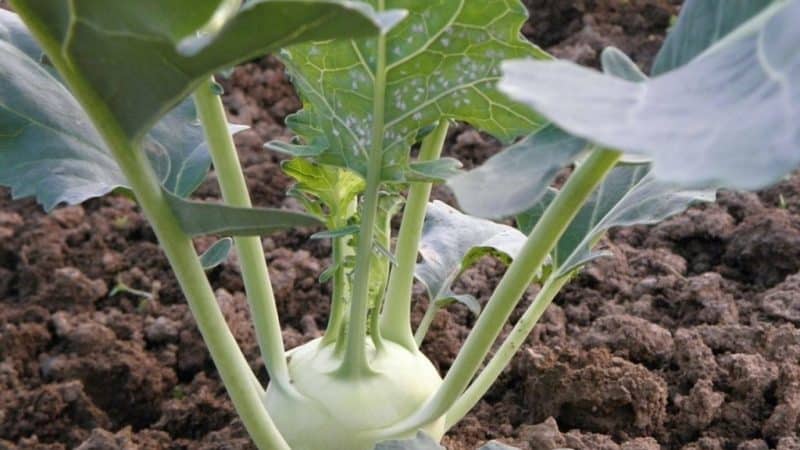
The seedling method is the most popular method of cultivating kohlrabi among gardeners.
Reference. For growing through seedlings, early varieties are chosen.
In order to harvest cabbage several times, seeds for seedlings are sown twice per season:
- in mid-March - the harvest ripens by early or mid-May;
- at the beginning of May - the harvest is ready for harvesting at the end of July.
Preparation of planting material
Preplanting seed preparation consists of several stages:
- Calibration The seed material is inspected and sorted, leaving medium-sized seeds for sowing.
- Germination test. The seeds are placed in a glass of water and those that remain on the surface are discarded.
- Disinfection. The planting material is wrapped in fabric, immersed in hot water (minimum +50°C) for half an hour, and then in cold water for 10 minutes.
- Improving germination. The seeds are soaked for 12 hours in a solution of a growth stimulator (Epin) and then washed.
- Hardening. Planting material is placed in the refrigerator for a day.
On the day of sowing, the seeds are removed from the refrigerator and dried in the fresh air.
Read also:
Sowing
To sow seeds, use a ready-made substrate for seedlings, which is sold in specialized stores, or make a soil mixture yourself, mixing sand, peat and turf soil in equal proportions with the addition of humus and wood ash.
The self-prepared substrate is pre-disinfected. To do this, it is spilled with a solution of potassium permanganate (1 g per 10 liters of water) or calcined for half an hour in an oven heated to +180°C.
Seeds are sown in special cassettes, disposable cups, wooden or plastic containers.
Sowing rules:
- Place a drainage layer of expanded clay or small pebbles on the bottom of the prepared container.
- Fill the container with a suitable substrate.
- Make planting furrows on its surface every 3-4 cm.
- Place the seeds in them at a distance of 3 cm from each other, deepening them by 1-1.5 cm.
- Sprinkle the seeds with soil and water generously with warm water.
- Cover the container with polyethylene to create a greenhouse effect.
The container with the crops is placed in a well-lit place, but protected from direct sunlight with an air temperature of +18...+20°C. The film is regularly removed for ventilation, and the soil is moistened with a spray bottle.
After the emergence of seedlings, the polyethylene is removed, the air temperature in the room is reduced to +10...+12°C for 10 days to avoid stretching of the sprouts, and then raised again to +18°C.
10-15 days before planting in open ground, seedlings begin to harden. To do this, the container with the crops is taken out into fresh air, first for 1.5-2 hours and this time is gradually increased to a day.
Reference. A week before transplanting into the beds, the seedlings stop watering.
Picking and transplanting seedlings into open ground
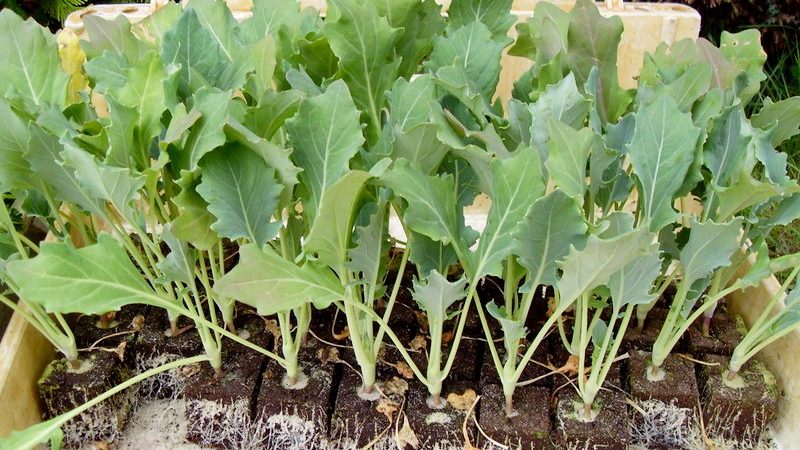
Kohlrabi seedlings react negatively to picking, so it is better to sow the seeds immediately in individual containers. When sown in a common container, the plants are planted in separate cups when they have 1 true leaf.
For 2-3 days after picking, the air temperature in the room with plants is maintained at +20...+22°C, then reduced to +17...+18°C during the day and to +8...+10°C at night.
Seedlings are transplanted into open ground approximately 5 weeks after sowing the seeds. By this time, the plants should have 4-5 true leaves.
Transplantation scheme:
- In the prepared area, form rows at a distance of 50 cm from each other.
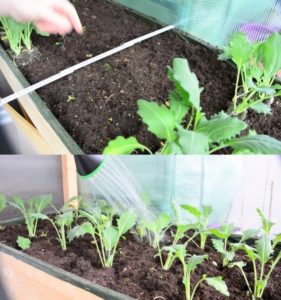
- Every 25-30 cm, dig planting holes in them, the diameter of which should correspond to the size of the root system along with the earthen ball.
- Mix part of the excavated soil with 1 tsp. urea, 2 tbsp. l. superphosphate and 2 tbsp. ash and water.
- Fill the holes one third with the resulting mixture.
- Water the plants generously, carefully remove them from the containers along with the earthen ball and place them in the center of the holes.
- Fill the voids with soil so that the seedlings are buried up to the cotyledon leaves.
- Compact and water the soil.
If at the time of planting the seedlings the average daily air temperature is less than +13...+17°C, the plantings are covered with polyethylene.
Direct sowing in open ground
Kohlrabi is grown not only through seedlings, but also by sowing seeds directly into the beds. The optimal time for this is the end of June, then the crop will be ready for harvesting in early October.
Selecting a location
To plant kohlrabi, choose a well-lit place protected from cold and gusty winds.The culture prefers loose, light and fertile soil, with good aeration, moisture permeability and low or medium acidity. The best option is loam.
Reference. In acidic and depleted soil, cabbage forms tough, with many coarse fibers.
Kohlrabi is not planted after cruciferous crops; the best predecessors are carrots, onions, tomatoes, potatoes, pumpkin, zucchini and legumes.
The site is prepared in the fall: the soil is cleared of plant debris, nutrients are scattered over the surface (1 tbsp wood ash, 1 tbsp superphosphate, 1 tsp urea and 3-4 kg of rotted manure or humus per 1 sq. m square) and dig it up onto the bayonet of a shovel.
To reduce acidity, additional lime or dolomite flour is added to the soil at the rate of 1 kg per 1 sq. m.
Step-by-step disembarkation instructions
The process of planting kohlrabi in the ground:
- In the prepared area, level the ground and mark the beds with a distance of 60-70 cm between them.
- Make planting furrows 1.5-2 cm deep in them.
- Place the seeds in them at a distance of 20-30 cm from each other.
- Sprinkle them with soil, compact them and water them.
In case of early sowing (in May), the beds are covered with film or agrofibre.
Care in the garden
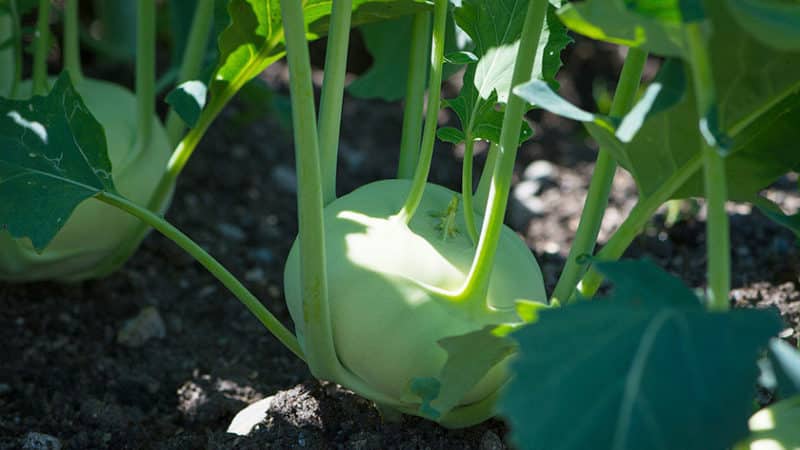
Proper care of kohlrabi cabbage is the key to a good harvest. After each watering or rain, the soil between the rows is loosened to a depth of no more than 8 cm in order to improve the air and moisture permeability of the soil and to avoid the formation of a dry crust on its surface.
At the same time, weeds are removed, which take moisture and nutrients from the soil and create a favorable environment for the development of pests and diseases.
The first hilling is carried out 3 weeks after planting the seedlings in the ground or in the phase of 5-6 true leaves and the procedure is repeated every 15 days.
Reference. The optimal temperature for cabbage development is +17°C.
Watering
This is a moisture-loving crop, so plantings are watered regularly and abundantly, focusing on weather conditions and the amount of precipitation. Drought provokes the formation of coarse kohlrabi pulp, and excessive moisture causes cracking of the stem fruits.
On average, during the first 2 weeks after planting seedlings in the beds, watering is carried out once every 2-3 days, then weekly.
Reference. The soil should not dry out more than 3-4 cm deep.
To retain moisture in the soil, the beds are mulched with straw or peat.
Feeding and fertilizer
If cabbage is planted in fertile and fertilized soil, phosphorus-potassium fertilizers are applied only in the phase of stem formation. This will help avoid excessive nitrate accumulation.
When growing kohlrabi in depleted soil, the plantings are watered 3 times per season with a nutrient solution (30 g of potassium sulfate, 25 g of ammonium nitrate and 28 g of superphosphate per 10 liters of water) at the rate of 5 liters per 1 sq. m. m.
Read also:
Early maturing cabbage hybrid Krautkaiser F1
What does ripe cabbage look like?
The size of the stem fruits indicates that the crop is ready for harvesting: they should weigh 90-120 g and have a diameter of 7-8 cm for early and medium varieties and 8-10 cm for late varieties.
Harvest in dry weather. The stem fruit is dug up with roots, dried for 2-3 hours, cleared of soil and the leaves are cut off.Vegetables sprinkled with sand and placed in wooden boxes are stored at a temperature of 0...+2°C and air humidity up to 95% for more than six months.
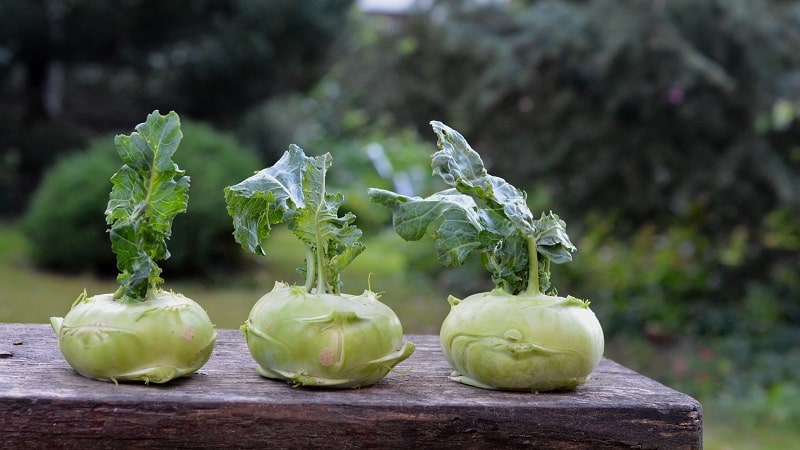
Conclusion
Despite the apparent complexity of cultivation, kohlrabi does not have any special care requirements. It can be grown through seedlings and by sowing seeds directly into the ground, and if you follow the planting rules and regular watering, even beginning gardeners can get 2 or even 3 harvests of vegetables per season.